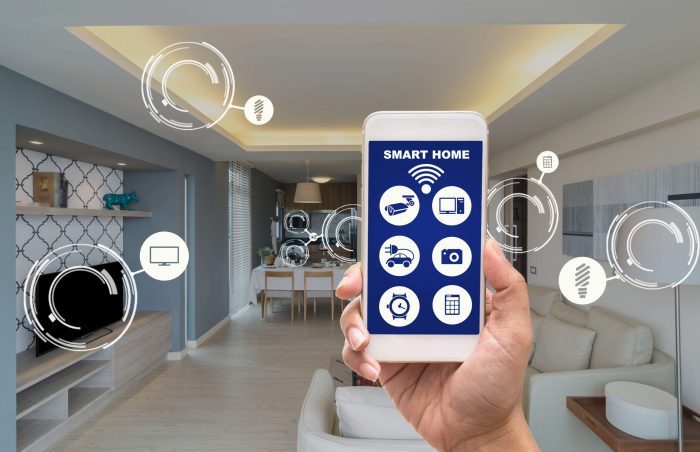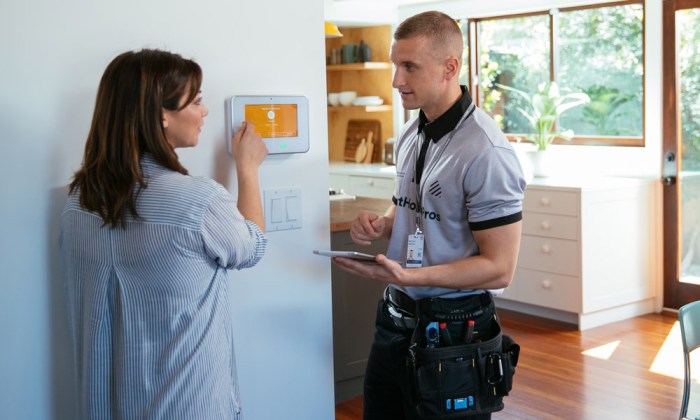Enhancing Security: Smart Security System Installation

With smart security system installation at the forefront, this paragraph opens a window to an amazing start and intrigue, inviting readers to embark on a storytelling filled with unexpected twists and insights. The world of smart security systems offers a modern approach to safeguarding your home or business, utilizing cutting-edge technology to provide peace of mind and enhanced protection.
From the benefits of installation to the intricate planning and integration with smart homes, this guide will delve into the realm of smart security systems in a comprehensive manner.
Importance of Smart Security System Installation

Installing a smart security system is crucial in today's world to ensure the safety and protection of your home or business. These systems offer a wide range of benefits that can greatly enhance security measures and provide peace of mind.
Enhanced Security Features
Smart security systems come equipped with advanced features such as motion sensors, video surveillance, and remote access capabilities. These features allow you to monitor your property in real-time, receive instant alerts in case of any suspicious activity, and even control the system remotely from your smartphone or computer.
Prevention of Burglaries and Break-Ins
One of the key benefits of a smart security system is its ability to deter burglaries and break-ins. The presence of visible security cameras and sensors acts as a strong deterrent for potential intruders. In case of any unauthorized entry, the system immediately sends alerts to you and authorities, increasing the chances of catching the intruders.
Examples of Benefits
Consider a scenario where a smart security system detects motion outside your home during the night. You receive an alert on your phone and quickly check the live video feed to see an intruder attempting to break in. You immediately notify the authorities, who arrive on the scene and apprehend the intruder, preventing any theft or damage to your property.In another instance, a business owner receives an alert on their phone about a fire alarm triggered at their store.
They remotely access the security cameras and see smoke coming from the back storage area. They quickly contact the fire department, who arrive in time to extinguish the fire and prevent a major disaster.These examples highlight how a smart security system can be a lifesaver in critical situations, showcasing the importance of investing in such systems for your home or business security.
Types of Smart Security Systems
Smart security systems come in various types with different features designed to cater to different security needs. Let's explore some of the common types available in the market.
1. Camera-based Smart Security Systems
Camera-based smart security systems are equipped with high-definition cameras that provide real-time video monitoring of your property. These systems often come with features like motion detection, night vision, and two-way audio communication.
2. Sensor-based Smart Security Systems
Sensor-based smart security systems rely on sensors to detect movement, entry, or changes in the environment. These systems can include door/window sensors, motion sensors, and glass break sensors to alert you of any suspicious activity.
3. Alarm-based Smart Security Systems
Alarm-based smart security systems are designed to trigger loud alarms in case of a security breach. These systems can be integrated with cameras and sensors for a comprehensive security solution.
Scalability of Smart Security Systems
Smart security systems are highly scalable, making them suitable for properties of all sizes. Whether you have a small apartment or a large estate, you can customize your smart security system to meet your specific needs. With the ability to add more cameras, sensors, and alarms as needed, smart security systems offer flexibility and adaptability for any property size.
Planning and Designing a Smart Security System
When it comes to planning and designing a smart security system, there are several important steps to consider to ensure optimal functionality and coverage. From strategically placing cameras to ensuring compatibility with other smart devices, each decision plays a crucial role in the overall effectiveness of the system.
Strategically Placing Cameras, Sensors, and Components
- Identify key entry points: Start by assessing your property and identifying key entry points such as doors, windows, and any other vulnerable areas.
- Position cameras strategically: Place cameras in areas that provide maximum coverage, ensuring there are no blind spots. Consider angles, lighting conditions, and potential obstructions.
- Install sensors strategically: Motion sensors and door/window sensors should be strategically placed to detect any unauthorized access or movement.
- Consider camera resolution: Higher resolution cameras provide clearer images, making it easier to identify individuals and details in case of an incident.
Considering Connectivity and Compatibility
- Choose a system with remote access: Opt for a smart security system that allows you to monitor your property remotely through a smartphone or computer.
- Ensure compatibility with other devices: If you have other smart devices in your home, make sure the security system is compatible and can integrate with them seamlessly.
- Check for wireless connectivity: Wireless systems offer flexibility and ease of installation, especially in older homes where wiring might be a challenge.
- Consider smart home automation: Look for a security system that can be integrated into a larger smart home automation setup for added convenience and control.
Installation Process of Smart Security Systems
Installing a smart security system involves a series of steps to ensure proper setup and functionality. It is essential to follow the installation process carefully to maximize the security benefits of the system.
General Installation Process
- Begin by identifying the areas of your property that require surveillance and determine the best locations for cameras and sensors.
- Install the cameras, sensors, and control panel according to the manufacturer's instructions, ensuring they are securely mounted and properly connected.
- Set up the monitoring and control software on your smartphone or computer to access the system remotely.
- Test the system to ensure all components are functioning correctly and adjust settings as needed for optimal performance.
Common Challenges and Solutions
- Challenge: Connectivity issues between devices and the control panel.
- Solution: Ensure all devices are within range of the control panel and check for any interference or obstacles causing signal disruptions.
- Challenge: Difficulty in configuring the software for remote access.
- Solution: Refer to the user manual or contact customer support for guidance on setting up remote monitoring and control.
Safety Precautions
- Always turn off the power supply before installing or servicing any components of the security system to prevent electrical accidents.
- Use proper tools and equipment to avoid injuries during installation, such as ladders for mounting cameras at elevated positions.
- Follow all safety guidelines provided by the manufacturer to prevent damage to the equipment and ensure personal safety.
Integrating Smart Security Systems with Smart Homes
Smart security systems can be seamlessly integrated into a broader smart home setup, allowing for a more convenient and efficient way to manage both security and home automation. By connecting smart security devices with other smart home devices, homeowners can create a centralized control system that enhances the overall safety and comfort of their living space.
Advantages of Centralized Control System
- Centralized Monitoring: With a centralized smart control system, homeowners can easily monitor and control their security cameras, alarms, and sensors from a single interface, providing a comprehensive view of their home's security status.
- Automation Integration: Integrating smart security systems with other smart devices like lights, locks, and thermostats enables automated responses to security events, such as turning on lights or adjusting the thermostat when motion is detected.
- Enhanced Convenience: Having a centralized control system allows for easier management of all smart devices in the home, streamlining daily routines and enhancing convenience for homeowners.
Examples of Integration with Other Smart Devices
- Smart Locks: Smart security systems can work in tandem with smart locks to provide keyless entry options and remotely control access to the home.
- Smart Lights: Smart security systems can trigger smart lights to turn on when motion is detected, creating a deterrent for potential intruders.
- Smart Thermostats: Integrating smart security systems with smart thermostats can help optimize energy usage by adjusting temperature settings based on occupancy and security status.
Final Thoughts

In conclusion, smart security system installation is not just about setting up cameras and sensors; it's about embracing a new way of ensuring safety and security. By understanding the importance, types, planning, and integration possibilities, you can take proactive steps to fortify your property.
With the right knowledge and approach, you can create a seamless blend of technology and security that caters to your specific needs. Stay informed, stay secure, and stay smart with your security system installation journey.
FAQ Summary
How can a smart security system benefit my home or business?
A smart security system provides real-time monitoring, remote access, and instant alerts, enhancing the overall security of your property.
What are the common challenges faced during smart security system installation?
Common challenges include connectivity issues, positioning cameras effectively, and ensuring compatibility with existing smart devices.
How do smart security systems integrate with other smart home devices?
Smart security systems can be integrated with lights, locks, thermostats, and other devices to create a centralized control system for enhanced automation and security.




